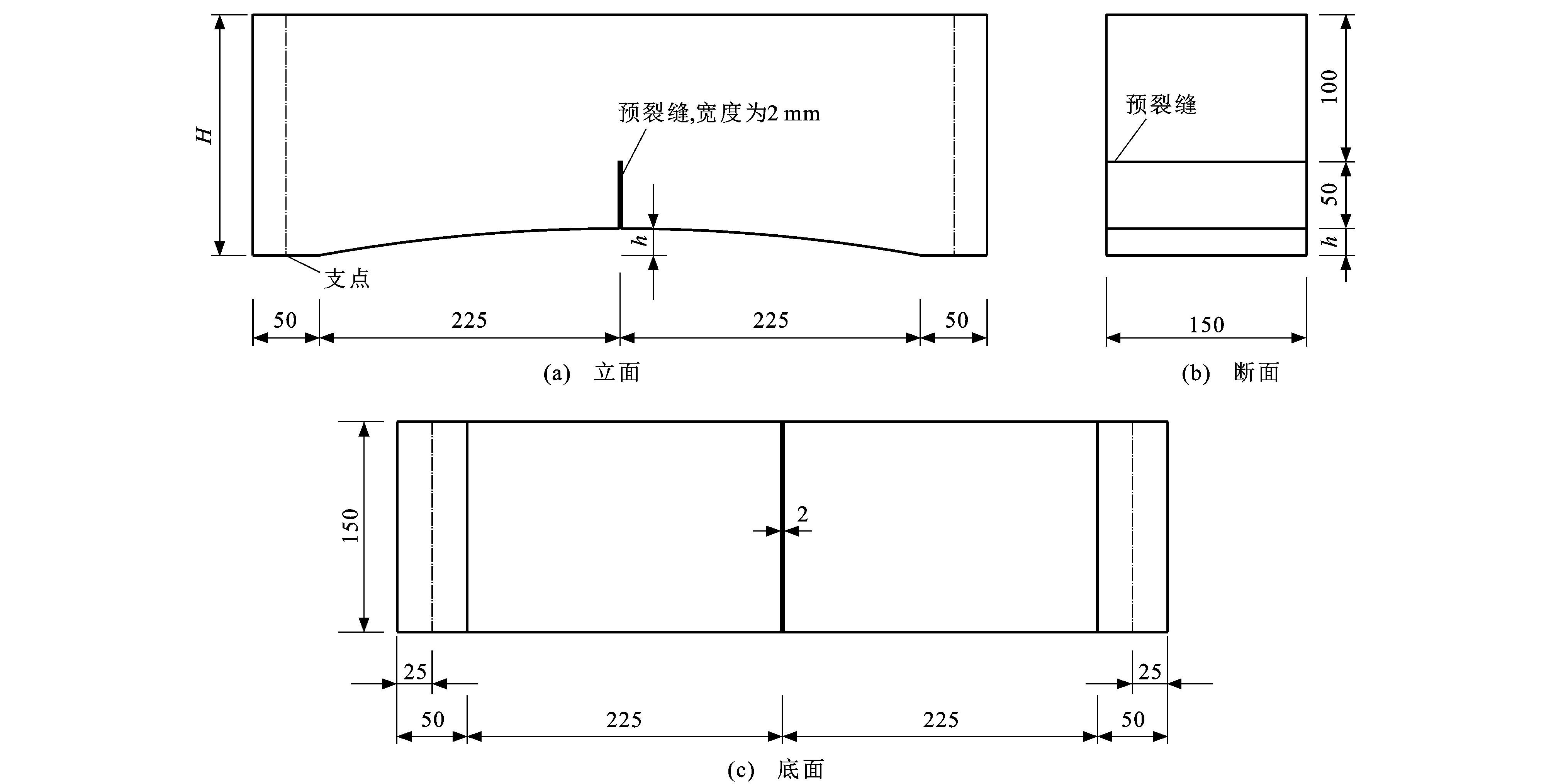String debonding effect of curved RC member reinforced by bonding FRP in intrados
-
摘要: 进行了26个曲面构件的FRP-混凝土界面粘贴试验, 研究了混凝土强度、FRP粘贴层数、FRP粘贴长度与构件曲率对粘贴强度、界面应变与破坏机理的影响。研究结果表明: 曲面混凝土构件内弧粘贴FRP易出现3种破坏形态: 弦剥离破坏、FRP在裂缝处被拉断和FRP在试件裂缝一侧发生剥离, 其中构件曲率越大, 越容易发生弦剥离破坏, 小曲率构件多发生FRP拉断破坏; 随外荷载的增大, FRP应变峰值有一个向后传递的变化过程, 说明沿纤维长度方向的FRP并不是全部参与工作, 存在一个有效工作(粘贴) 长度; 对本试验数据采用虚拟零点方法分析得出, 曲面混凝土构件内弧粘贴FRP有效粘贴长度约为14 cm; 曲率对粘贴强度影响显著, 曲率增大, 纤维应变梯度增大, 有效粘贴长度变小, 粘贴强度降低; 曲率相同时, 纤维层数越多, 沿纤维方向应变分布越均匀, 粘贴强度越大, 但是这一增长并非与FRP层数成线性关系, 2层纤维粘贴强度约为1层的1.5倍; 当纤维层数增加时, 粘贴层法向应力增大较快, 试件更易发生弦剥离破坏, 这种破坏是由法向粘贴应力与面内剪应力的耦合效应引起的; 粘贴层应力函数可用内弧曲率圆心角的余弦函数表示, 当矢高分别为30、60、90 mm时, 构件平均误差分别为7.7%、2.4%与8.8%, 因此, 函数精度较高。Abstract: The bonding tests of FRP (fiber reinforced polymer/plastic)-concrete interfaces of 26 curved surface specimens were executed, and the influences of concrete strength, FRP bonding layer numbers, FRP bonding length, and component curvatures on the adhesive strength, interface strain and failure mechanism were investigated. Research result shows that there are three kinds of failure modes in curved concrete members, including the string peeling, FRP fracture at the crack, FRP peeling on the crack side. The greater the curvature of the component, the more likely the string peeling will occur. FRP tensile failure often occurs in small curvature members. With the increase of external load, the peak value of FRP strain has a backward transfer process. It is shown that the FRP along the fiber length is not all involved in the work, and there is an effective working (bonding) length. The analysis result of the test data by the virtual zero point method shows that the effective length of FRP pasted on curved concrete members is about 14 cm. The curvature has a significant effect on the adhesive strength. With the increase of the curvature, the changing gradient of the fiber strain increases, the effective adhesive length becomes shorter, and the adhesive strength decreases. When the curvature is the same, the more the number of fiber layers, the more uniform the strain distribution along the fiber direction and the higher the adhesive strength. But this increase is not linear with the number of FRP layers, and the adhesive strength with two layers of fiber is about 1.5 times of that with one layer. When the number of fiber layers increases, the normal stress of the adhesive layer increases rapidly, and the specimens are more prone to string-debonding failure. This failure is caused by the coupling effect between the normal bonding stress and in-plane shear stress. The stress function of the pasting layer can be expressed by the cosine function of the center angle of internal arc curvature. When the vector height is 30, 60, and 90 mm, the average error of the component is 7.7%, 2.4%, and 8.8%, therefore, the function has higher accuracy.
-
表 1 试件参数
Table 1. Specimen parameters
编号 混凝土等级 粘贴层数 粘贴长度/mm 矢高/mm C30-1-175-0 C30 1 175 0 C30-1-125-30 1 125 30 C30-1-175-30 1 175 30 C30-1-225-30 1 225 30 C30-2-175-30 2 175 30 C30-1-125-60 1 125 60 C30-1-175-60 1 175 60 C30-1-225-60 1 225 60 C30-2-175-60 2 175 60 C30-1-125-90 1 125 90 C30-1-175-90 1 175 90 C30-1-225-90 1 225 90 C30-2-175-90 2 175 90 C40-1-175-0 C40 1 175 0 C40-1-125-30 1 125 30 C40-1-175-30 1 175 30 C40-1-225-30 1 225 30 C40-2-175-30 2 175 30 C40-1-125-60 1 125 60 C40-1-175-60 1 175 60 C40-1-225-60 1 225 60 C40-2-175-60 2 175 60 C40-1-125-90 1 125 90 C40-1-175-90 1 175 90 C40-1-225-90 1 225 90 C40-2-175-90 2 175 90 表 2 试验结果
Table 2. Test results
试件编号 极限承载力/kN 破坏形态 C30-1-175-0 52.82 P2 C30-1-125-30 45.13 P3 C30-1-175-30 45.77 P2 C30-1-225-30 46.25 P3 C30-2-175-30 53.16 P1 C30-1-125-60 42.84 P1 C30-1-175-60 43.24 P1 C30-1-225-60 43.84 P1 C30-2-175-60 52.25 P1 C30-1-125-90 40.28 P1 C30-1-175-90 34.40 P1 C30-1-225-90 39.74 P1 C30-2-175-90 52.25 P1 C40-1-175-0 53.12 P2 C40-1-125-30 48.21 P2 C40-1-175-30 48.77 P2 C40-1-225-30 49.73 P1 C40-2-175-30 54.22 P3 C40-1-125-60 45.29 P1 C40-1-175-60 46.14 P1 C40-1-225-60 46.89 P1 C40-2-175-60 54.99 P1 C40-1-125-90 38.70 P1 C40-1-175-90 39.31 P1 C40-1-225-90 40.92 P1 C40-2-175-90 54.99 P1 -
[1] 张剑, 叶见曙, 王景全, 等. 预应力混杂碳/玻璃(C/G) 纤维布加固RC梁的应力重分布[J]. 交通运输工程学报, 2017, 17 (1): 45-52. doi: 10.3969/j.issn.1671-1637.2017.01.006ZHANG Jian, YE Jian-shu, WANG Jing-quan, et al. Stress redistribution of RC beams strengthened with prestressed hybrid carbon/glass (C/G) fiber cloth[J]. Journal of Traffic and Transportation Engineering, 2017, 17 (1): 45-52. (in Chinese). doi: 10.3969/j.issn.1671-1637.2017.01.006 [2] MEI Kui-hua, LI Ya-juan, LU Zhi-tao. Application study on the first cable-stayed bridge with CFRP cables in China[J]. Journal of Traffic and Transportation Engineering (English Edition), 2015, 2 (4): 242-248. doi: 10.1016/j.jtte.2015.05.004 [3] 谢建和, 孙明炜, 郭永昌, 等. FRP加固受损RC梁受弯剥离承载力预测模型[J]. 中国公路学报, 2014, 27 (12): 73-79. doi: 10.3969/j.issn.1001-7372.2014.12.009XIE Jian-he, SUN Ming-wei, GUO Yong-chang, et al. Prediction model for debonding bearing capacity of damaged reinforced concrete beam flexurally strengthenecl with fiber reinforced polymer[J]. China Journal of Highway and Transport, 2014, 27 (12): 73-79. (in Chinese). doi: 10.3969/j.issn.1001-7372.2014.12.009 [4] REN Wei, SNEED L H, GAI Yi-ting, et al. Test results and nonlinear analysis of RC T-beams strengthened by bonded steel plates[J]. International Journal of Concrete Structures and Materials, 2015, 9 (2): 133-143. doi: 10.1007/s40069-015-0098-3 [5] 李炳宏, 江世永, 飞渭, 等. 纤维增强塑料筋混凝土梁抗弯设计数值分析[J]. 长安大学学报(自然科学版), 2011, 31 (5): 50-56. https://www.cnki.com.cn/Article/CJFDTOTAL-XAGL201105010.htmLI Bing-hong, JIANG Shi-yong, FEI Wei, et al. Numerical analysis of flexural design of concrete beams reinforced with FRP bars[J]. Journal of Chang'an University (Natural Science Edition), 2011, 31 (5): 50-56. (in Chinese). https://www.cnki.com.cn/Article/CJFDTOTAL-XAGL201105010.htm [6] ZHOU Ying-wu, WU Yu-fei, YUN Yan-chun. Analytical modeling of the bond-slip relationship at FRP-concrete interfaces for adhesively-bonded joints[J]. Composites Part B: Engineering, 2010, 41 (6): 423-433. doi: 10.1016/j.compositesb.2010.06.004 [7] KO H, MATTHYS S, PALMIERI A, et al. Development of a simplified bond stress-slip model for bonded FRP-concrete interfaces[J]. Construction and Building Materials, 2014, 68: 142-157. doi: 10.1016/j.conbuildmat.2014.06.037 [8] SELMAN E, ALVER N. A modified fiber-reinforced plastics concrete interface bond-slip law for shear-strengthened RC elements under cyclic loading[J]. Polymer Composites, 2016, 37 (12): 3373-3383. doi: 10.1002/pc.23535 [9] YUAN Hong, LU Xu-sheng, HUI D, et al. Studies on FRP-concrete interface with hardening and softening bond-slip law[J]. Composite Structures, 2012, 94 (12): 3781-3792. doi: 10.1016/j.compstruct.2012.06.009 [10] YANG Qi-fei, MENG Qing-lin. Ultimate slip between FRP and concrete on their interface[J]. Advanced Materials Research, 2011, 383-390: 852-855. doi: 10.4028/www.scientific.net/AMR.383-390.852 [11] YIN Yu-shi, FAN Ying-fang. Research on interfacial bond-slip constitutive relation between FRP and concrete based on two parameters[J]. IOP Conference Series: Earth and Environmental Science, 2017, 108 (2): 584-587. [12] 施嘉伟, 朱虹, 吴智深, 等. FRP片材-混凝土界面应变率效应试验研究[J]. 土木工程学报, 2012, 45 (12): 99-107. https://www.cnki.com.cn/Article/CJFDTOTAL-TMGC201212012.htmSHI Jia-wei, ZHU Hong, WU Zhi-shen, et al. Experimental study of the strain rate effect of FRP sheet-concrete interface[J]. China Civil Engineering Journal, 2012, 45 (12): 99-107. (in Chinese). https://www.cnki.com.cn/Article/CJFDTOTAL-TMGC201212012.htm [13] LEE Y J, BOOTHBY T E, BAKIS C E, et al. Slip modulus of FRP sheets bonded to concrete[J]. Journal of Composites for Construction, 1999, 3 (4): 161-167. doi: 10.1061/(ASCE)1090-0268(1999)3:4(161) [14] WU Zhi-shen, ISLAM S M, SAID H. A three-parameter bond strength model for FRP-concrete interface[J]. Journal of Reinforced Plastics and Composites, 2009, 28 (19): 2309-2323. doi: 10.1177/0731684408091961 [15] GRAVINA R J, AYDIN H, VISINTIN P, Extraction and analysis of bond-slip characteristics in deteriorated FRP-to-concrete joints using a mechanics-based approach[J]. Journal of Materials in Civil Engineering, 2017, 29 (6): 04017013-1-14. [16] 潘毅, 吴晓飞, 郭瑞, 等. 长期荷载作用下FRP约束混凝土应力-应变关系分析模型[J]. 建筑结构学报, 2017, 38 (10): 139-148. https://www.cnki.com.cn/Article/CJFDTOTAL-JZJB201710017.htmPAN Yi, WU Xiao-fei, GUO Rui, et al. Analysis-oriented stress-strain model of FRP-confined concrete under long-term sustained load[J]. Journal of Building Structures, 2017, 38 (10): 139-148. (in Chinese). https://www.cnki.com.cn/Article/CJFDTOTAL-JZJB201710017.htm [17] YAO J, TENG J G, CHEN J F. Experimental study on FRP-to-concrete bonded joints[J]. Composites Part B: Engineering, 2005, 36 (2): 99-113. doi: 10.1016/j.compositesb.2004.06.001 [18] BENRAHOU K H, ADDA BEDIA E A, BENYOUCEF S, et al. Interfacial stresses in damaged RC beams strengthened with externally bonded CFRP plate[J]. Materials Science and Engineering: A, 2006, 432 (1/2): 12-19. [19] 陆新征, 叶列平, 滕锦光, 等. FRP-混凝土界面粘结滑移本构模型[J]. 建筑结构学报, 2005, 26 (4): 10-18. doi: 10.3321/j.issn:1000-6869.2005.04.002LU Xin-zheng, YE Lie-ping, TENG Jin-guang, et al. Bond-slip model for FRP-to-concrete interface[J]. Journal of Building Structures, 2005, 26 (4): 10-18. (in Chinese). doi: 10.3321/j.issn:1000-6869.2005.04.002 [20] WU Zhi-gen, LIU Yi-hua. Singular stress field near interface edge in orthotropic/isotropic bi-materials[J]. International Journal of Solids and Structures, 2010, 47 (17): 2328-2335. doi: 10.1016/j.ijsolstr.2010.04.033 [21] 杨德厚. 曲轴构件FRP-混凝土界面粘结试验研究[D]. 西安: 长安大学, 2014.YANG De-hou. Bonding experiment research of crankshaft specimen FRP-concrete interface[D]. Xi'an: Chang'an University, 2014. (in Chinese). [22] KHAN M A, EL-RIMAWI J, SILBERSCHMIDT V V. Relative behaviour of premature failures in adhesively plated RC beam using controllable and existing parameters[J]. Composite Structures, 2017, 180: 75-87. doi: 10.1016/j.compstruct.2017.08.006 [23] ALAM M S, HUSSEIN A. Relationship between the shear capacity and the flexural cracking load of FRP reinforced concrete beams[J]. Construction and Building Materials, 2017, 154: 819-828. doi: 10.1016/j.conbuildmat.2017.08.006 [24] AL-ABDWAIS A H, AL-MAHAIDI R S. Bond properties between carbon fibre reinforced polymer (CFRP) textile and concrete using modified cement-based adhesive[J]. Construction and Building Materials, 2017, 154: 983-992. doi: 10.1016/j.conbuildmat.2017.08.027 [25] HERBRAND M, ADAM V, CLASSEN M, et al. Strengthening of existing bridge structures for shear and bending with carbon textile-reinforced mortar[J]. Materials, 2017, 10 (9): 1-15. [26] RAOOF S M, KOUTAS L N, BOURNAS D A. Bond between textile-reinforced mortar (TRM) and concrete substrates: experimental investigation[J]. Composites Part B: Engineering, 2016, 98: 350-361. doi: 10.1016/j.compositesb.2016.05.041 [27] DALALBASHI A, GHIASSI B, OLIVEIRA D V, et al. Fiber-to-mortar bond behavior in TRM composites: effect of embedded length and fiber configuration[J]. Composites Part B: Engineering, 2018, 152: 43-57. [28] CAGGEGI C, LANOYE E, DJAMA K, et al. Tensile behaviour of a basalt TRM strengthening system: influence of mortar and reinforcing textile ratios[J]. Composites Part B: Engineering, 2017, 130: 90-102. [29] D'ANTINO T, CARLONI C, SNEED L H, et al. Matrix-fiber bond behavior in PBO FRCM composites: a fracture mechanics approach[J]. Engineering Fracture Mechanics, 2014, 117: 94-111. [30] SNEED L H, D'ANTINO T, CARLONI C. Investigation of bond behavior of polyparaphenylene benzobisoxazole fiber-reinforced cementitious matrix composite-concrete interface[J]. ACI Materials Journal, 2014, 111 (5): 569-580. -





 下载:
下载:
















